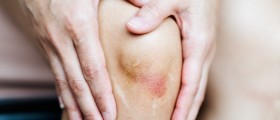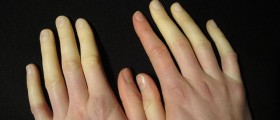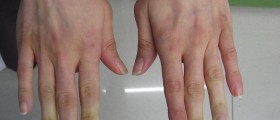
People suffering from epidermolysis bullosa (EB) experience skin problems (blisters) after minor injuries of the skin or after exposure to heat. Sometimes, just scratching or rubbing the skin may provoke similar problems, especially among young children, even babies who are born with blisters on the skin. Most cases of epidermolysis bullosa are notices in early childhood but there are some patients who remain undiagnosed until adolescence.
In general, this skin condition is inherited from parents who might but do not always have to experience symptoms of epidermolysis bullosa themselves. EB patients can have mild symptoms and get better with years, but some of them may experience plenty of pain, skin infections and other problems associated with this skin condition.
Epidermolysis Bullosa Complications
Serious forms of epidermolysis bullosa may be complicated by secondary skin infections, sepsis, malnutrition, anemia, eye problems, deformities and lead to skin cancer or even death.
Secondary skin infections are frequent among EB patients, since the skin is already damaged and can be easily infected with staphylococcus bacteria or other microorganisms. Besides the skin, bacteria could enter the bloodstream and spread to different parts of the body, provoking severe problem known as sepsis. This condition can lead to shock, organ failure and be a cause of death.
Malnutrition may occur in children who happen to develop blisters in the mouth and on other mucous membranes. Some children may develop anemia due to lack of important nutrients or as a consequence of bleeding from open sores (blisters).
Additional health complications of epidermolysis bullosa are deformities and eye disorders, depending on the affected part of the body. Serious EB is known to cause abnormal bending of joints in the fingers, toes and elbows (contractures) and also fusion of the fingers or toes. On the other hand, if EB triggers inflammation of conjunctiva of the eye, it can be responsible for corneal erosion and loss of vision.
Certain types of epidermolysis bullosa are associated with high risk for development of squamous cell carcinoma (type of skin cancer), while junctional EB is sometimes seen to cause infections, loss of body fluids, blistering of internal organs, breathing problems and even lethal outcome.
How to Treat Epidermolysis Bullosa?
This skin condition is not curable, according to current medical knowledge. Treatment depends on the severity of the condition, but it is usually focused on relieving discomfort and prevention of pain and other possible medical problems that may arise.
Skin care may involve puncturing blisters with a sterile needle, leaving them to drain and then application of certain antibiotic or some other ointments.
Skin grafts are usually recommended if the wounds do not heal for a while. Surgical procedures are commonly used to correct deformities of the fingers or toes or to dilate esophagus if necessary. Physical therapy is also necessary, especially for motion limitations due to scarring or contractures. Some children affected by epidermolysis bullosa may need a feeding tube in order to achieve proper feeding and adequate amount of important nutrients.

















Your thoughts on this
Loading...